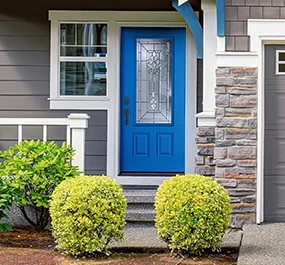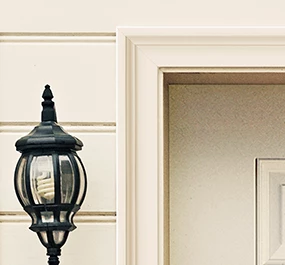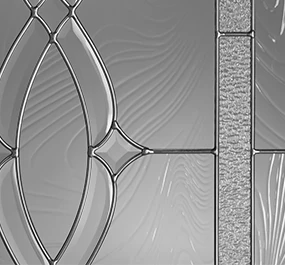Your home is meant to be a bastion of safety and privacy, both keeping you secure on the inside and keeping the rest of the world at a safe distance on the outside—except those parts of the world you choose to let in.
If a home is serving these important needs but it has an exterior door that’s less than soundproof, it can feel like there are prying ears eavesdropping on your private moments or unwanted visitors in the form of loud noises invading from beyond your front door.
If alarming sounds or privacy concerns are impacting your ability to unwind and relax in your own home, odds are a door is one of your home’s least effective barriers between you and the rest of the world.
Yes, a door is meant to be the entryway through which a home is entered, but when shut, it’s also trusted to provide the same sort of security a solid wall lends to a home. If that security seems compromised by sound, there are ways you can take action against this unwanted breach.
Can You Soundproof an Existing Door?
If you’ve decided to do something about an overabundance of noise or lack of privacy, you may be wondering if you can improve your existing entryway’s ability to soundproof your home or if doing so will require an outright replacement of the offending exterior door.
Luckily, there are a number of ways to create a DIY soundproof door without investing in a full front door home improvement project. While most methods involve some form of door reinforcement, to soundproof a door may not always mean you need to alter the door itself.
Soundproofing a Door: DIY Solutions
Soundwaves are a form of energy that travels through whatever obstacles are in its way—whether that’s wood, glass, water or the air itself—on the journey to your ears. It does so through the vibrations of particles, but the higher a particle’s density, the harder it is for sound to move through it.
This is why it’s hard to hear someone standing on the other side of a wall, which is made up of the interior and exterior exposed material, along with any insulation or other construction contained within.
Doors need to open to be functional, so they don’t benefit from the same sort of multi-layer sound protection as the rest of a room’s solid, stationary set of walls. However, there are ways to enhance a door’s ability to keep unwanted aural visitors from seeing themselves into your space.
Sealing Gaps
This is the first option on the list because it’s the best way to answer the question, “What is the cheapest way to soundproof a door?”
You may already have this soundproofing method started on your exterior door and not even know it. Most doors that lead to the outside have some sort of protection against the outside elements built into place, usually as part of the frame.
If you can see light or feel air coming through your door, it's time to seal the gaps. In addition to helping solve your soundproofing issues, gap sealing can help keep insects out of a home and assist with high energy costs.
The easiest way to complete this project is to purchase weather stripping tape from any retail hardware store. It’s that tape with the thick rubber on the ends, and it’s extremely easy to both install or remove without causing any damage to a door or its frame.
The door and its frame are just one point of contact that could potentially create gaps between your home and the rest of the world. The frame is also affixed to the wall, and if it’s less than snug, this is yet another avenue for sound to enter unobstructed. Create a particle-sized traffic jam by filling those gaps frame-to-wall with acoustic caulking, another cheap and easy way for you to do some DIY soundproofing.
In this scenario, using acoustic caulking is important—the word acoustic means having to do with sound, so this caulk is specifically designed to take care of issues with noises coming in or going out. To apply this caulk, you’ll also need to pick up a caulk gun if you don’t have one at home.
Apply a Door Sweep
During the winter, did your parents or grandparents place a towel or blanket at the bottom of a door to keep out the cold? They were creating their own DIY door sweep, something you can use to keep sound from traveling through the gap between a door and the floor!
Using something as thin as a towel won’t do much, but it’s possible to make your own door stop with a little bit of foam, some fabric and a sewing machine. If you’d prefer the look of a manufactured product—and, honestly, the superior protection one would offer—there’s a whole market of options waiting to come between you and your door.
The easiest option here is also the most effective. Silicone door sweeps can provide multi-layer protection with products that adhere to doors, reliably remain in place and usually come close to matching the existing color of a door. These can be just as easy to remove as they are to install, making them an ideal option for renters or homeowners who may not want their door sweeps to be permanent fixtures. This option is cheap, too.
The bottom of a door can’t be caulked or weather stripped like the top and sides, but a door sweep allows for similar protection from sound leakage. It’ll also provide similar protection from the cold and unwanted invaders, like mice.
Sound Absorbing Items in Your Home
What household items can you use to soundproof a door? Well, you may be covered in one of them right now.
Hanging a large, heavy blanket or quilt on a door can help add multiple layers to the door’s sound-stopping potential. Hang the quilt with nails or hooks that come with adhesive like the kind you’d use to hang photo frames.
You could also use furniture to block some sound from any unused doors, purchase a soundproof blanket or hang soundproof curtains. Sometimes, the answer to, “how do I stop sound from coming through my door,” might be the same method as how to keep out sound and light.
Factors that Affect Soundproofing
From gaps around a door to the extra density that can be added in an effort to introduce more particles between you and the outdoors, soundproofing is an exercise towards one goal: keeping you and your family safe from the dangers and distractions of sound leakage or pollution. The factors that go into achieving this goal contribute to two measuring systems called the Outdoor/Indoor Transmission Class and Sound Transmission Class, ways of rating doors for their ability to soundproof a space.
While the STC measures a door’s ability to block sounds in the frequency range of common household distractions like music, televisions, spoken word and pet sounds, the OITC covers a wider frequency range. Notably, the OITC’s range goes low enough to include roadway noise.
There are also factors that may impact soundproofing but not necessarily change a door’s STC or OITC rating, like the placement of a door in relation to the most prominent sources of noise. Other factors also include the quality of a door’s installation, the inclusion of glass in a door’s construction, the use of side lights, and the material used to seal a door.
Best Soundproof Entry Door Materials
Sometimes, doors need a little help when they’re working to keep your home a quaint, quiet place. One DIY method not described above involves using foam to create a core in an existing door. Even though this method can be extremely helpful, it’s also risky as it requires you to cut open a door, fill it with foam then seal the door back up. Even if it is successfully completed, the odds of stylizing the door to look the same as it did before it was cut into are low.
With Plastpro’s fiberglass doors, this method of soundproofing isn’t necessary, as they already come with a pre-installed polyurethane foam core. Even if they don’t come with foam, fiberglass doors are a great soundproofing option thanks to the layering method used to craft a door from fiberglass. Metal has similar soundproofing power thanks to layering, but the foam core and improved durability help push fiberglass over the finish line first. Some woods have great inherent density, but the proofing added with foam and layering is superior.
Soundproofing Your Door with Plastpro
The Polyurethane foam core is an important distinction to make in a Plastpro product, because it provides better sound protection than a polystyrene foam core. With the superior soundproofing foam in place and layers of fiberglass surrounding it, Plastpro’s doors provide a trustworthy barrier against sound coming in or going out. The doors are also customizable and match with a variety of architectural and design styles.
You can use our test results and search tool to easily see for yourself the STC and OITC rating of any given Plastpro product. Sort by series type, model, height and glass type to explore the range of soundproofing options available to you.
Find a Plastpro dealer to begin your soundproofing project today!



